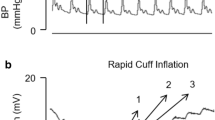Summary
The requirement for using an arterial occlusion cuff at the wrist when measuring forearm blood flows by plethysmography was tested on a total of 8 subjects at rest and during and after sustained and intermittent isometric exercise. The contribution of the venous effluent from the hand to the forearm flow during exercise was challenged by immersing the arm in water at 20, 34, and 40‡ C. Occlusion of the circulation to the hand reduced the blood flow through the resting forearm at all water temperatures. There was an inverse relationship between the temperature of the water and the proportion in the reduction of forearm blood flow upon inflation of the wrist-cuff, ranging from 45 to 19% at 20‡ to 40‡ C, respectively. However, during sustained isometric exercise at 10% of the subjects maximum voluntary contraction (MVC) there was no reduction in the measured forearm flow when an arterial occlusion cuff was inflated around the wrist. Similarly, there was no alteration in the blood flow measured 2 s after each of a series of intermittent isometric contractions exerted at 20% or 60% MVC for 2 s whether or not circulation to the hand was occluded nor of the post-exercise hyperemia following 1 min of sustained contraction at 40% MVC. These results indicate that a wrist-cuff is not required for accurate measurement of forearm blood flows during or after isometric exercise.
Similar content being viewed by others
References
Barcroft, H., Edholm, O. G.: The effect of temperature on blood flow and deep temperature in the human forearm. J. Physiol. 102, 5–20 (1943)
Clarke, R. S. J.: An investigation by new methods of the action of physical and chemical stimuli on human blood vessels. Thesis, Queen's University of Belfast, 1958
Clarke, R. S. J., Hellon, R. F.: Venous collection in forearm and hand measured by the strain-gauge and volume plethysmographs. Clin. Sci. 16, 103–117 (1957)
Clarke, R. S. J., Hellon, R. F., Lind, A. R.: Duration of sustained contractions of the human forearm at different muscle temperatures. J. Physiol. 143, 454–473 (1958)
Coles, D. R., Cooper, K. E.: Hyperaemia following arterial occlusion or exercise in the warm and cold human forearm. J. Physiol. 145, 241–250 (1959)
Cooper, K. E., Randall, W. C., Hertzman, A. B.: The vascular convection of heat from active muscle to overlying skin. A.F. Technical Report No. 6680, Part 7, Wright Air Development Center, Ohio, 1951
Grant, R. T., Pearson, R. S. B.: The blood circulation in the human limb's observations on the differences between the proximal and distal parts and remarks on the regulation of body temperature. Clin. Sci. 3, 119–139 (1938)
Humphreys, P. W., Lind, A. R.: The blood flow through active and inactive muscles of the forearm during sustained hand-grip contractions. J. Physiol. 166, 120–135 (1963)
Kerslake, D. Mck.: The effect of the application of an arterial occlusion cuff to the wrist on the blood flow in the human forearm. J. Physiol. 108, 451–457 (1949)
Lind, A. R., Williams, C. A.: The control of blood flow through human forearm muscles following brief, isometric contractions. J. Physiol. 288, 529–547 (1979)
Mellander, S.: Effects of selected vasoactive agents on resistance exchange and capacitance vessels in skeletal muscle. In: Physiology and pharmacology of vascular neuroeffector systems, J. A. Bevan, R. F. Furchgott, R. A. Maxwell, A. P. Somlyo (eds.), p. 333. Basel: Karger 1971a
Mellander, S.: Interaction of local and nervous factors in vascular control. Angiology 8, 187–194 (1971b)
Mottram, R. F.: Blood flow and muscle contraction in the forearm. J. Physiol. 182, 27–28P (1965)
Quinn, R. S.: Wrist cuffs for forearm plethysmography. J. Physiol. 179, 62–63P (1965)
Shepherd, J. T.: Physiology of the circulation in human limbs in health and disease. London, Philadelphia: Saunders 1963
Shepherd, J. T., Vanhoutte, P. M.: Veins and their control, pp. 99–112. London, Philadelphia: Saunders 1975
Whitney, R. J.: The measurement of volume changes in human limbs. J. Physiol. 121, 1–27 (1953)
Whitney, R. J.: Circulatory changes in the forearm and hand of man with repeated exposure to heat. J. Physiol. 125, 1–24 (1954)
Williams, C. A., Lind, A. R.: Study of metabolic and myogenic factors in post-contraction vasodilatation. Fed. Proc. 37, 654 (1978)
Author information
Authors and Affiliations
Additional information
This work was supported by N.I.H. training grant HLO 7050-03, H.E.W. contract 210-77-0044 and Air Force grant AFOSR-76-3084 B
Rights and permissions
About this article
Cite this article
Williams, C.A., Lind, A.R. Measurement of forearm blood flow by venous occlusion plethysmography: Influence of hand blood flow during sustained and intermittent isometric exercise. Europ. J. Appl. Physiol. 42, 141–149 (1979). https://doi.org/10.1007/BF00431020
Accepted:
Issue Date:
DOI: https://doi.org/10.1007/BF00431020




